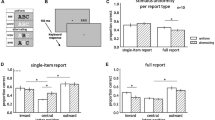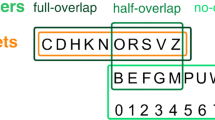Abstract
The present study deals with the question of how crowding effects, which are interactions among adjacent features or characters, emerges automatically or by so-called higher level controlled processing. Two experiments are presented comparing performances during detecting, localizing, and identifying a flanked target in same strings when the target was defined on the basis of either its form or its category. Detection and localization performances were better for form- relative to category-defined targets whereas the reverse was observed for identification performance. This shows that the interacting information is indeed high level in that it is affected by task settings like the defining target feature and the observers’ task set. The results suggest that crowding effects do not emerge due to processes depending on the parameters of stimulus presentation, but due to processes activated by certain task sets.


Similar content being viewed by others
References
Ahissar, M., & Hochstein, S. (2004). The reverse hierarchy theory of visual perceptual learning. Trends in Cognitive Sciences, 8, 457–464.
Aubert, H., & Foerster, R. (1867). Beitraege zur Kenntniss des indirecten Sehens. Untersuchungen ueber den Raumsinn der Retina (Contributions to the knowledge of indirect vision. Studies on the spatial sense of the retina). Archiv fuer Ophthalmologie, 3 (2), 1–37.
Bachmann, T. (1989). Microgenesis as traced by the transient paired-forms paradigm. Acta Psychologica, 70, 3–17.
Bachmann, T. (2000). Microgenesic approach to the conscious mind. Amsterdam: John Benjamins
Bouma, H. (1970). Interaction effects in parafoveal letter recognition. Nature, 226, 177–178.
Brainard, D. H. (1997). The psychophysics toolbox. Spatial Vision, 10, 433–436.
Coltheart, M., Curtis, B., Atkins, P., & Haller, M. (1993). Models of reading aloud: Dual-route and parallel-distributed-processing approaches. Psychological Review, 100, 589– 608.
Coltheart, M., Rastle, K., Perry, C., Langdon, R., & Ziegler, J. (2001). DRC: A dual route cascaded model of visual word recognition and reading aloud. Psychological Review, 108, 204–256.
Eriksen, B. A., & Eriksen, C. W. (1974). Effects of noise letters upon the identification of a target letter in a nonsearch task. Perception & Psychophysics, 16, 143–149.
Grainger, J., & Jacobs, A. M. (1996). Orthographic processing in visual word recognition: A multiple read-out model. Psychological Review, 103, 518–565.
Hochstein, S., & Ahissar, M. (2002). View from the top: Hierarchies and reverse hierarchies in perceptual learning. Neuron, 36, 791–804.
Huckauf, A., & Heller, D. (2002). Spatial selection in peripheral letter recognition: In search of boundary conditions. Acta Psychologica, 111, 101–123.
Huckauf, A., & Heller, D. (2004). On the relations between crowding and visual masking. Perception & Psychophysics, 66, 584–595.
Huckauf, A., Heller, D., & Nazir, T. A. (1999). Lateral masking: Some limitations of the feature interaction account. Perception & Psychophysics, 61, 177–189.
McClelland, J. L., & Rumelhart, D. E. (1981). An interactive activation model of context effects in letter perception: Part 1. An account of basic findings. Psychological Review, 88, 375–407.
Merikle, P. M. (1980). Selection from visual persistence by perceptual groups and category membership. Journal of Experimental Psychology: General, 109, 279–295.
Pelli, D. G. (1997) The VideoToolbox software for visual psychophysics: Transforming numbers into movies. Spatial Vision, 10, 437–442.
Pelli, D. G., Palomares, M., & Majaj, N. J. (2004). Crowding is unlike ordinary masking: Distinguishing feature detection and integration. Journal of Vision, 4, 1136–1169.
Posner, M. (1980). Orienting of attention. Quarterly Journal of Experimental Psychology, 32, 3–25.
Reicher, G. M. (1969). Perceptual recognition as a function of meaningfulness of stimulus material. Journal of Experimental Psychology, 81, 274–280.
Sanocki, T. (1987). Visual knowledge underlying letter perception: Font-specific, schematic tuning. Journal of Experimental Psychology: Human Perception and Performance, 13, 267–278.
Sperling, G. (1960). The information available in brief visual presentations. Psychology Monographs, 74, Whole No. 498.
Treisman, A., & Paterson, R. (1984). Emergent features, attention, and object perception. Journal of Experimental Psychology: Human Perception and Performance, 10, 12–31.
Von Wright, J. M. (1968). Selection in immediate visual memory. Quarterly Journal of Experimental Psychology, 20, 62–68.
Wheeler, D. D. (1970). Processes in word recognition. Cognitive Psychology, 1, 59–85.
Wolfe, J. M., Cave, K. R., & Franzel, S. L. (1989). Guided search: An alternative to the feature integration model for visual search. Journal of Experimental Psychology: Human Perception and Performance, 15, 419–433.
Wolford, G. (1975). Perturbation model for letter identification. Psychological Review, 82, 184–199.
Acknowledgements
Thanks to Hans Strasburger and Dirk Vorberg for extremely constructive and helpful comments on an earlier version of the manuscript and to Daniela Krause, Marion Kulik, Malte Heinbockel, and Mario Urbina for assistance in data collection and analysis.
Author information
Authors and Affiliations
Corresponding author
Rights and permissions
About this article
Cite this article
Huckauf, A. Task set determines the amount of crowding. Psychological Research 71, 646–652 (2007). https://doi.org/10.1007/s00426-006-0054-6
Received:
Accepted:
Published:
Issue Date:
DOI: https://doi.org/10.1007/s00426-006-0054-6




